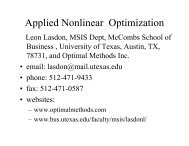[PDF] ALIO Back Matter
[PDF] ALIO Back Matter
[PDF] ALIO Back Matter
You also want an ePaper? Increase the reach of your titles
YUMPU automatically turns print PDFs into web optimized ePapers that Google loves.
SB14<br />
2 - A Solution to Distribution Network Design and Truck Load Problem<br />
in the Surroundings of the Optimal<br />
Roberto P. Castillo, President, Geogestión SA, Padilla 972,<br />
Buenos Aires, Argentina, robertopcastillo@gmail.com<br />
The strategy to diminish the logistic and transportation costs through lowering<br />
tariffs or outsourcing services has a limit. At that point, we propose a deep revision<br />
of the SCM and to develop mathematical models to support and integrate the<br />
decision making process. The improvements in the management planning processes<br />
bring about important savings and simultaneously increase the quality ratios. A<br />
software tool prototype and the underlying metaheuristic model will be presented as<br />
an example.<br />
3 - Sustainable Supply Chain Network Design:<br />
A Multicriteria Perspective<br />
Anna Nagurney, John F. Smith Memorial Professor, University of<br />
Massachusetts, Isenberg School of Management, Amherst, MA,<br />
01003, United States of America, nagurney@gbfin.umass.edu,<br />
Ladimer Nagurney<br />
In this paper we develop a rigorous modeling and analytical framework for the<br />
design of sustainable supply chain networks. We consider a firm that seeks to<br />
minimize the total cost associated with design / construction and operation, and to<br />
minimize the emissions generated, with an appropriate weight, associated with the<br />
various supply chain network activities. We provide both the network optimization<br />
model and an algorithm to illustrate the modeling and algorithmic approach.<br />
4 - Modeling and Optimization in Supply Chains of Biomass<br />
Tiago Gomes, Universidade do Minho, Escola de Engenharia,<br />
Campus de Gualtar, Braga, 4710 - 057, Portugal,<br />
tiago.gomes@dps.uminho.pt, Filipe Alvelos, Maria Sameiro Carvalho<br />
An integer programming model to support tactical and operational decisions in a<br />
biomass supply chain is proposed. The supply chain is a sequence of activities that<br />
source (e.g. the harvest of forest residues), transform and deliver final products to<br />
end costumers and may include intermediate warehouses. The model involves the<br />
collection of raw material, wood chipping, facility location, transportation and<br />
inventory decisions with the aim of minimizing total costs and to meet customer<br />
demand.<br />
■ SB14<br />
Aula 365- Third Floor<br />
Quantitative Finance<br />
Cluster: Game Theory and its Applications<br />
Invited Session<br />
Chair: Nicolas Merener, Professor, Universidad Torcuato Di Tella, 1010<br />
Saenz Valiente, Buenos Aires, 1426, Argentina, nmerener@utdt.edu<br />
1 - Pricing Contingent Capital with a Book-value Trigger<br />
Paul Glasserman, Professor, Columbia University, 403 Uris Hall,<br />
New York, NY, 10028, United States of America,<br />
pg20@columbia.edu, Behzad Nouri<br />
Among the solutions proposed to the problem of banks “too big to fail” is contingent<br />
capital in the form of debt that converts to equity when the firm’s capital ratio falls<br />
below a threshold. We derive closed-form expressions to value such securities when<br />
the firm’s assets are modeled as geometric Brownian motion and the conversion<br />
trigger is based on a book-value capital ratio.<br />
2 - The Cost of Latency<br />
Ciamac Moallemi, Assistant Professor, Columbia University,<br />
New York, NY, United States of America, ciamac@gsb.columbia.edu,<br />
Mehmet Saglam<br />
Electronic markets have experienced dramatic improvements in latency, or, the<br />
delay between a trading decision and the resulting trade execution. We describe a<br />
model that allows for the quantitative valuation of latency. Our model is<br />
surprisingly simple and provides a closed-form expression for the cost of latency, in<br />
terms of well-known parameters of the underlying traded asset. Our method<br />
provides a useful “back-of-the-envelope” calculation to assess the importance of<br />
latency.<br />
3 - Optimal IPO Timing in an Exchange Economy<br />
Jaime Casassus, Assistant Professor of Financial Economics, Pontificia<br />
Universidad Católica de Chile, Av. Vicuna Mackenna 4860, Santiago,<br />
Chile, jcasassu@ing.puc.cl, Mauro Villalon<br />
We model the IPO decision of an entrepreneur in an exchange economy. The<br />
entrepreneur holds a Lucas Tree, and when the IPO occurs, the market converges to<br />
a Two Trees economy built on Cochrane, Longstaff, and Santa-Clara (2008). We<br />
solve the optimal timing problem and study the diversification effects over the firm’s<br />
value and entrepreneur’s consumption. The model predicts that IPOs should be<br />
correlated with the firm’s size and explains why firms with lower betas are expected<br />
to IPO first.<br />
<strong>ALIO</strong> / INFORMS International – 2010<br />
32<br />
4 - Efficient Valuation for Derivatives on Discrete Variance<br />
Nicolas Merener, Professor, Universidad Torcuato Di Tella, 1010<br />
Saenz Valiente, Buenos Aires, 1426, Argentina, nmerener@utdt.edu,<br />
Leonardo Vicchi<br />
We value derivative contracts written on discretely realized variance. We assume an<br />
underlying driven by Gaussian shocks and modulated by an autonomous stochastic<br />
volatility process. This formulation includes several standard models as special cases.<br />
Prices are high dimensional integrals, which we compute efficiently through the<br />
combination of numerical integration over privileged directions and Monte Carlo<br />
simulation.<br />
■ SB15<br />
Aula 351- Third Floor<br />
Rough Sets for Knowledge Discovery, Knowledge<br />
Management and Decision Making<br />
Sponsor: Data Mining:<br />
Knowledge Discovery and Data Mining for Decision Making<br />
Sponsored Session<br />
Chair: Rafael Bello, Professor, UCLV, Universidad Central de Las Villas,<br />
Santa Clara, Cuba, rbellop@uclv.edu.cu<br />
1 - Compensatory Fuzzy Rough Sets<br />
Rafael Bello, Professor, UCLV, Universidad Central de Las Villas,<br />
Santa Clara, Cuba, rbellop@uclv.edu.cu, Rafael Espin<br />
The basic concepts of RST are the lower and upper approximations of a concept<br />
according to an indiscernibility relation. In this paper, the concept is defined by<br />
using a logical predicate, and the relation is replaced by a logical expression. We<br />
apply the rough set approach to approximate a logical predicate P according to fuzzy<br />
values in the context of the compensatory fuzzy logic.<br />
2 - Analysis of a Baseline Schedule in a International Project: Case<br />
Study in the Sector of Oil and Gas<br />
Rubiao Gomes Torres Júnior, Msc, Intertechma/Ibmec-RJ, Rua<br />
Moura Brasil 74- 801 Laranjeiras, Rio de Janeiro, 22231200, Brazil,<br />
rubtor@attglobal.net, Camila Torres<br />
This paper aims to analyze a baseline schedule, in an international project in the<br />
light of a methodology for project management. For it is taken as a base case of a<br />
project undertaken by a bi-national association formed by a Brazilian company and<br />
one of Ecuador for the implementation of a project in the oil and gas in Ecuador.<br />
This work concludes presenting suggestions, where the more intensive use of a<br />
methodology for project management, could help in meeting deadlines.<br />
3 - A Model of Feature Selection Based on Rough Set Theory and Ant<br />
Colony Optimization Applied to Climatic Forecasting<br />
Yudel Gomez, Professor, UCLV, Sta Clara, 54830, Cuba,<br />
ygomezd@uclv.edu.cu, Ann Nowe, Rafael Bello<br />
This work deals with application of Machine Learning techniques to the climatic<br />
forecasting. A novel algorithm of feature selection (FS) in distributed environment is<br />
applied and it is tested for rain forecasting. The FS is based on the Rough Set Theory<br />
and metaheuristic ACO with a multicolony variant. The data gathered in several<br />
meteorological stations in the neighborhood are transformed in datasets in form of<br />
decisions systems.<br />
4 - Improving the k-NN Method for the Function Approximation<br />
Problem using Similarity Relations<br />
Yaima Filberto, Professor, Universidad de Camaguey, Circunvalacion<br />
Norte km 4, Camaguey, Cuba, ayudier@uclv.edu.cu, Rafael Bello,<br />
Yaile Caballero, Rafael Larrua<br />
K-NN method is the most known lazy learning method. The weights assign to<br />
features have an important role in the accuracy of the results. This improvement is<br />
obtained due to by a more effective recovery of the similar cases. We propose a<br />
method based on the extended RST that allows performing a feature selection<br />
process by finding the weight for the predictive features. The method for calculating<br />
the weights of the features improvement the k - NN method.


![[PDF] ALIO Back Matter](https://img.yumpu.com/17932960/12/500x640/pdf-alio-back-matter.jpg)
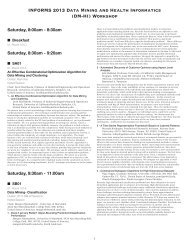
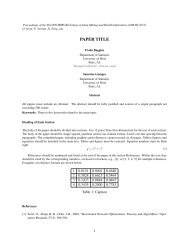
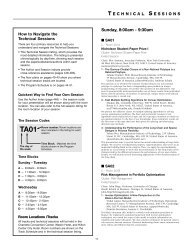
![[PDF] Charlotte Back Matter](https://img.yumpu.com/17933057/1/190x245/pdf-charlotte-back-matter.jpg?quality=85)

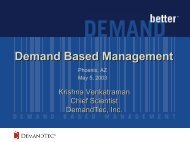
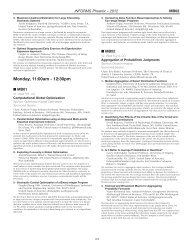
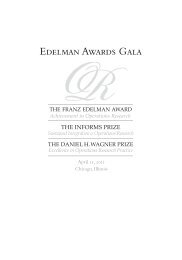
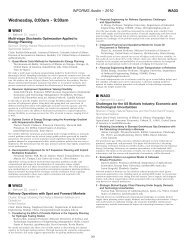
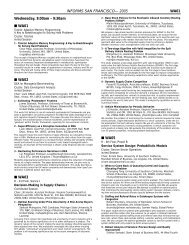
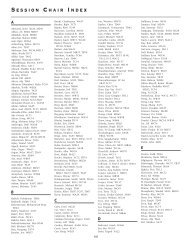
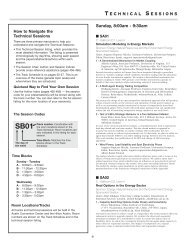
![[PDF] Monday, 8:00am - 9:30am](https://img.yumpu.com/17932954/1/190x245/pdf-monday-800am-930am.jpg?quality=85)
